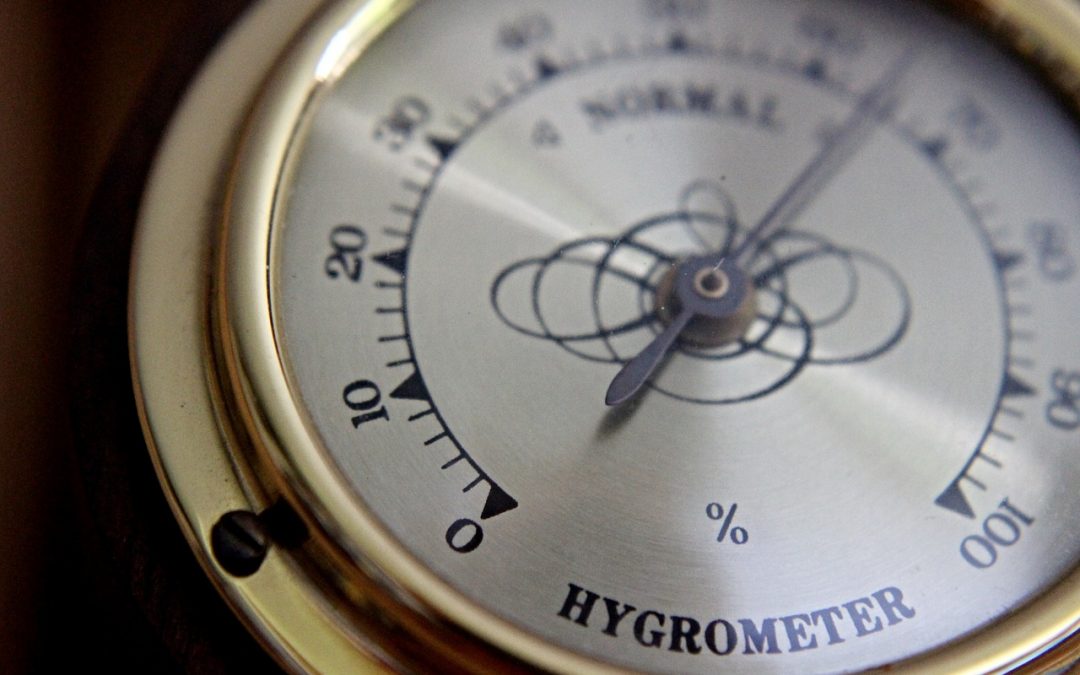Old man winter will soon depart, and spring will arrive. Time to open the windows and let the fresh air flush out winter dryness! The spring air is invigorating – UNTIL – spring rains come. Then the “fresh” air makes the house feel clammy and humid. You think, “I’ll run the air conditioner- that will make it more comfortable!” You set the thermostat down a few degrees only to realize the house is already cool and you’re about to make it colder. Now what do you do?
First, let’s take a look at what causes high humidity, particularly in the spring. High humidity levels in the home are usually due to moist outside air silently migrating into the home, typically from spring rain, through leaks in the walls, windows and doors. Of course, the high humidity could also be from showers and cooking, which can happen anytime of the year. High humidity in the spring, however, is most likely due to wet outside conditions.
For newer homes that are very air-tight, the moisture can have a more direct path if the home is equipped with a whole house ventilation system that brings outside air directly to the home. While operating to provide fresh air, as required by modern building code, ventilation systems can bring a significant amount of moisture directly into the home from the outdoors. Moisture also enters the home in liquid form from the saturated ground, which allows water vapor to migrate up from the foundation, basement or crawlspace.
Opening the windows might help purge the dryness of the winter, if the air outside is dry, but if not, provides another direct path for humid air to enter the home. In fact, it would be better to keep the windows closed after a spring rain no matter how “fresh” the air might feel.
So, what can you do?? The most effective approach, but certainly not the easiest, is to keep the moisture from entering in the first place. Even if you cannot stem the flow of moisture completely, whatever you can do to reduce the moisture inflow makes it easier to remove it after it enters the home.
Below are different options to manage high humidity in a home, each providing different levels of humidity management at varying increments in cost:
1. Seal those Leaks
Identify and seal air and water leaks that provide a migration path for the moisture. The repairs can range from DIY fixes to professional house air leakage testing, which will identify hidden leaks that DIY repairs miss. DIY repairs include: replacing window and door gaskets, patching weeper leaks in basements and crawlspaces, routing gutter downspouts to discharge rain far away from the house, and sealing all exterior wall penetrations so they are watertight (dryer vent duct, exhaust fan ducts, spigots, roof flashings, windows and doors). Also make sure that all dampers to the outside are freely operable and shut when not in use, such as a fireplace damper, bath exhaust fans or whole house ventilation system.
2. Hire a Professional
A more effective alternative to DIY is to hire a certified building performance professional to test the house for air leakage. These professionals can run a blower door test to measure and identify house air leakage and run a duct leakage test to measure air leakage to/from outside the house. Once the major sources of air leakage are determined, the house and duct system can be more effectively sealed.
3. Install a Ventilation Humidity Control
For newer homes equipped with a whole house ventilation system, ask your HVAC contractor if a ventilation humidity control can be installed so the ventilation system is shut OFF whenever outside moisture levels are high. For an existing ventilation system, a thermostat like the Honeywell VISIONPRO® 8000 WITH REDLINK™, with optional outside air sensor set for high dewpoint lockout, will shut the system down when outdoor air is too moist. If you have a small duct connected to the duct system from the outdoors, consider a smart damper accessory such as the Aprilaire Model 8126X Ventilation Control System, which will not ventilate if the outdoor air raises indoor relative humidity above 55%.
4. Consider an “Overcool to Dehumidify” Feature
Options 1 through 3 will reduce the amount of moisture that can enter the home; however, they will not completely eliminate the potential for high indoor humidity, especially during cool wet weather. So what else can you do? Consider an “overcool to dehumidify” feature.
- One way to reduce the high humidity, once present, is to have your HVAC contractor install a thermostat that has an “overcool to dehumidify” feature, such as that found on the Ecobee SmartThermostat, Ecobee3 lite, or Carrier EB-STATE3LTP-02. These thermostats have a humidity sensor that can turn the air conditioner ON to keep humidity from exceeding a maximum level. In doing so, the air conditioner is allowed to overcool the house – up to 3 degrees cooler than the thermostat setting. The challenge is during mild weather, the air conditioner will reach the overcool limit quickly and shut off, while the humidity still exceeds the maximum level.
- For better “overcool to dehumidify” performance, consider an indoor air handler or gas furnace that is “overcool to dehumidify” compatible and is equipped with a brushless DC blower motor. When there is a call to dehumidify, the air handler will run at a lower speed, thus maximizing the moisture removal capacity of the air conditioner. This increases the potential for limiting the maximum humidity without excessive overcooling of the house.
5. Install a Whole House Dehumidifier
If the house cannot be made more air-tight, and an “overcool to dehumidify” thermostat does not completely mitigate high humidity, the most effective alternative is to install a whole house dehumidifier. The key benefit of a whole house dehumidifier is that it removes moisture and reduces humidity without overcooling the house. Of course, a whole house dehumidifier comes in all shapes and sizes. Even if you are unable to implement options 1-4 above, the more that can be done to keep moisture from entering the home, the smaller (and less costly) the whole house dehumidifier will need to be.
Now with all that being said, I am NOT suggesting to NOT open windows in the spring. Cool fresh spring air IS invigorating – so long as it’s not full of moisture. You CAN open the windows without worrying about high humidity if you follow one simple guideline – check the dewpoint temperature of outside air. You can find this on any weather site for your area or during the local TV weather forecast. The dewpoint temperature is an indicator of the amount of moisture in air, in absolute terms. If it is less than 60 deg F, you can be fairly assured opening the windows and letting in outside air will not lead to high indoor humidity – at least until it rains.
Contact Us to discuss the best way to limit the humidity in your home.






